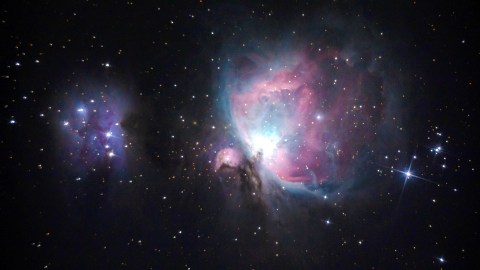Astrophysicist claims “dark fluid” fills the missing 95% of the Universe

Credit: YE AUNG THU/AFP/Getty Images.
- An astrophysicist and cosmologist Dr. Farnes published a paper while at Oxford University with a novel explanation for dark energy and dark matter.
- His theory claims to explain the missing 95% of the observable universe by the existence of “dark fluid”.
- This fluid has negative mass, repelling other materials.
While it seems we are making great strides in unlocking the mysteries of the Universe, there is a sizable hole in what we know – up to 95% of the cosmos appears to be missing. We are talking about dark matter and dark energy, two useful, groundbreaking, but yet-to-be-directly-observed explanations for the vast majority of what exists. While there have been various attempts to pin down these ideas, inferred from their gravitational effects, a recent theory from a University of Oxford scientist claims to do away with them entirely. Instead, his model proposes something which may be even more unusual – what if the Universe is actually filled with a “dark fluid” possessing “negative mass”?
Dark matter takes up 27% of the known Universe (per NASA), while dark energy, a repulsive force that makes the Universe expand, gets 68%. Only 5% of the Universe is the observable world, including us and our planet. According to the model, proposed by Dr. Jamie Farnes, both dark matter and dark energy are unified in a fluid which has “negative gravity”. It repels all other material away.
“Although this matter is peculiar to us, it suggests that our cosmos is symmetrical in both positive and negative qualities,” wrote Farnes, astrophysicist, cosmologist and data scientist who worked at Oxford at the time of publishing his paper, and has since moved on to Faculty, a leading AI company.
Negative matter was previously discredited because it was concluded that such a material would become less dense with the further expansion of the Universe. Yet that’s not how dark energy seems to be, with research showing it would not thin out over time. The study by Dr. Farnes proposes there’s a “creation tensor” that would allow for negative masses to be continuously created and not become diluted, behaving “exactly like dark energy, as the cosmologist explains.
Dr. Farnes sees his work to be building on Albert Einstein’s, who in 1917 discovered the cosmological constant, which became associated with dark energy in modern research.
“Previous approaches to combining dark energy and dark matter have attempted to modify Einstein’s theory of general relativity, which has turned out to be incredibly challenging,” said Dr. Farnes, adding “This new approach takes two old ideas that are known to be compatible with Einstein’s theory—negative masses and matter creation—and combines them together.”
Check out the dark matter halo simulation created by Dr. Farnes:
This computer simulation is based on the properties of negative mass, predicting the formation of dark matter halos like those inferred by observations via radio telescopes.
Testing the theory by Dr. Farnes will fall to the Square Kilometre Array (SKA), the world’s largest telescope to be built in Australia and South Africa between 2020 and 2025. This international radio telescope project would have an area of one square kilometer and be 50 times more sensitive than any other radio instrument in existence.
Since Farnes’s theory is speculative at this point, the scientific community has been split in its reviews of his work.
Physicist Krzysztof Bolejko from the University of Tasmania in Australia, said: “Farnes’ maths is fine”, and that he believes “Inside cosmic voids the signal will be clearer and so it will be easier to distinguish between processes caused by dark energy and those caused by a constantly created matter with negative mass”.
Alex Murphy, Professor of Nuclear & Particle Astrophysics at the University of Edinburgh, conceded that Farnes’s discoveries had an elegance and that “It’s one of many efforts trying to provide answers to deeply troubling issues with our understanding of the contents of the universe. It’s just possible that an idea like this might provide the breakthrough that’s needed”.
However, others were more critical with Sabine Hossenfelder from the Frankfurt Institute for Advanced Studies, noting that: “negative masses have not revolutionized cosmology” while “Farnes in his paper instead wants negative gravitational masses to mutually repel each other. But general relativity won’t let you do this”. She also took issue with the “creation tensor,” stating “A creation term is basically a magic fix by which you can explain everything and anything”.
Further tests will show whether the theory holds, but in the meantime you can read Dr. Farnes’s paper yourself in Astronomy and Astrophysics.





